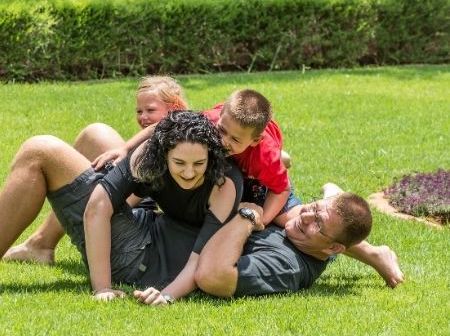Grasshoppers (Orthoptera: Acrididae) are common insects in Florida’s natural areas. They are among the most abundant herbivores in grassland ecosystems and are an important source of food for wildlife, especially birds. There are about 70 species of grasshoppers in Florida. Some species are quite rare and endangered, or unique to Florida.
Grasshopper species tend to have similar life histories. Eggs, clumped together in pods, are deposited in soil. Typically there are five or six immature (nymphal) forms (instars) between the egg and adult stages. Normally there is only one complete life cycle per year, but several species have more than one generation.
Feeding habits vary greatly. Some species feed only on grasses, some only on broadleaf plants, while others feed on a large number of different plants. One species of grasshopper found in Florida, Schistocerca ceratiola Hubbell & Walker, is quite unusual in that if feeds only one species of plant, a shrub known as Florida rosemary. Many species will consume dried plant material as well as green, and even exhibit cannibalism. Often grasshoppers will disperse when favored food plants are depleted, moving into nearby crops or ornamental plants.
Pictured below are some of the more common species. For a complete overview of Florida’s grasshoppers see Capinera et al. (2001), which can be purchased in hard copy or downloaded for free (https://entnemdept.ifas.ufl.edu/ghopper/ghopper.html).
GREEN SLANTFACED GRASSHOPPER, DICHROMORPHA VIRIDIS (SCUDDER)
This is generally the most abundant grasshopper in low grasses. Even lawns may support a significant population of this species. Color varies from entirely green to entirely brown.
Credit: UF/IFAS
LINEARWINGED GRASSHOPPER, APTENOPEDES SPHENARIODES (SCUDDER)
Commonly found in lush, weedy areas, the linearwinged grasshopper is representative of the few species which have markedly reduced wings as adults. Adults bear very small wing pads that are barely visible and completely nonfunctional for flight.
Credit: UF/IFAS
SOUTHERN GREENSTRIPED GRASSHOPPER, CHORTOPHAGA AUSTRALIOR (REHN & HEBARD)
This species is found where soil is bare or disturbed. Male and female grasshoppers make a crackling or buzzing sound in flight. The hind wing is transparent basally but smoky distally. Brown and green forms of this species occur.
Credit: UF/IFAS
SOUTHERN REDLEGGED GRASSHOPPER, MELANOPLUS PROPINQUUS (SCUDDER)
This is probably the most common grasshopper in disturbed and weedy areas. It sometimes damages crops and home gardens. At least two generations occur annually.
Credit: UF/IFAS
OBSCURE GRASSHOPPER, SCHISTOCERCA OBSCURA (FABRICIUS)
This species belongs to a group of especially strong fliers called “bird” grasshoppers. Its taste for certain valuable ornamental plants such as hibiscus often brings it into conflict with humans.
Credit: UF/IFAS
WRINKLED GRASSHOPPER, HIPPISCUS OCELETE (SCUDDER)
A grass feeder, this species may occasionally be numerous enough to damage pastures in north Florida. The hind wings are yellow or rose-colored basally, with a broad dark band.
Credit: UF/IFAS
SOUTHERN LUBBER GRASSHOPPER, ROMALEA GUTTATA (HOUTTUYN)
This large, flightless grasshopper is perhaps the best-known grasshopper in Florida. Frequently observed crossing highways and invading yards, it sometimes damages certain plants, especially ornamental plants and vegetables. It is an occasional pest of citrus. This colorful grasshopper varies quite a lot in appearance, ranging from almost entirely yellow to almost entirely black, but usually some combination of yellow and black. It may expel air from its trachea (small holes in it sides that allow it to breathe), producing a hissing sound, and sometimes froth, when handled. As a nymph, it is black, with a narrow red or yellow stripe running along its back. These insects are unusually difficult to kill with insecticides.
Credit: UF/IFAS
Credit: UF/IFAS
AMERICAN BIRD GRASSHOPPER, SCHISTOCERCA AMERICANA (DRURY)
This strong flier is probably the most damaging species in Florida, feeding on a wide variety of herbaceous and woody plants. It damages field crops, vegetables, ornamentals and trees. Unlike most grasshoppers, it commonly perches in trees, flying to the ground or short vegetation to feed and then moving back to the trees. Citrus has been severely damaged, although it is not highly preferred. This species normally has two generations per year and is unusual in that it overwinters as an adult, rather than the egg, as occurs in most grasshoppers. Nymphs are normally green, but when they are numerous their color shifts to orange.
Credit: UF/IFAS
Credit: UF/IFAS
REFERENCES
Capinera, J.L., C. W. Scherer, and J. M. Squitier. 2001. Grasshoppers of Florida. Gainesville, FL: University Press of Florida.
Capinera, J. L., R. D. Scott, and T. J. Walker. 2004. Field Guide to Grasshoppers, Katydids, and Crickets of the United States. Ithaca, NY: Cornell University Press.
FOOTNOTES
1. This document is SP98, one of a series of the Department of Entomology and Nematology, UF/IFAS Extension. Original publication date January 1992. Revised February 1997, June 2009, and June 2018. Visit the EDIS website at https://edis.ifas.ufl.edu.2. J. L. Capinera, emeritus professor, Department of Entomology and Nematology; UF/IFAS Extension, Gainesville, FL 32611.

